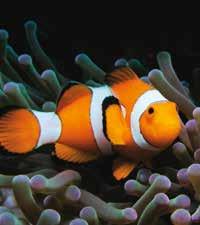
65 minute read
ECOSYSTEMS
How do we balance our needs with those of the environment?
CHAPTER
2.1 All living things are dependent on each other and the environment around them 2.2 Relationships between organisms may be beneficial or detrimental Introducing a new species 2.4 may disrupt the balance in What if? an ecosystem Yeast cultures
What you need:
2.5 Energy enters the ecosystem through photosynthesis Spatula, dried yeast, warm water, sugar, test tube, ruler, thermometer, timer
What to do:
1 Add 1 spatula of dried yeast to warm 2.6 Energy flows through an ecosystem water in the test tube and leave for 10–15 minutes before adding 1 spatula of sugar. 2 Measure the temperature of the water at the point of adding the sugar. 2.7 Matter is recycled in ecosystems 3 Measure the height of the yeast culture (an indication of the number of yeast cells) from the base of the test tube. This is the measurement at t = 0 minutes. 4 Measure the height of the culture every minute for 15 minutes. 5 Draw a graph of your results.
What if?
» What if hot water was added to the culture? (Would the number of yeast cells increase faster?) » What if ice-cold water was added to the culture? » What if twice as much sugar was added? • What if no sugar was added?
2.3
Population size depends on abiotic and biotic factors
ECOSYSTEMS 2 Natural events can disrupt an ecosystem2.8 Human activity can disrupt an ecosystem2.9 DRAFT ONLY - NOT FOR SALE Science as a human endeavour: 2.10 Human management of ecosystems continues to change No part of this publication may be reproduced, stored in a retrieval system or transmitted in any form or by any means.
2.1
In this
topic, you • An ecosystem is a community of living organisms (biotic) and their non-living will learn surroundings (abiotic). that: • Ecology is the study of the interrelationships of organisms with other organisms and with their non-living environment.
The biosphere – a home for our ecosystems
The biosphere is the living world. It is where all the plants, insects and animals live. The biosphere includes any place on Earth where life of any kind can exist. The biosphere can be thought of as the intersection between the atmosphere (gases), the hydrosphere (water) and the lithosphere (land). Because the biosphere is large, and its relationships are complex, we normally study smaller components of the biosphere, called ecosystems.
Ecosystems
Ecosystems vary in size. They can be as small as a puddle or as large as the Earth itself. Any group of biotic (living) and abiotic (non-living) things interacting with each other in a selfsustaining way is an ecosystem. Ecosystems are made up of habitats. A habitat is the place where a population of organisms live. Habitats vary in
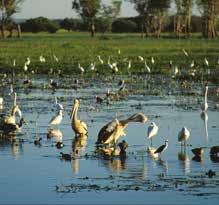
size depending on the amount of food, water and shelter they provide. A population is a group of living organisms that are the same species, living in the same place at the same time. When different populations interact with each other, they are called a community. For example, a population of humans can live in a town together. When all the plants in their gardens and their pets are included, then it becomes a community. The habitat must supply all the needs of the organisms, such as food, water, warm temperatures, oxygen and minerals. These make up the non-living, abiotic conditions of the habitat. If the abiotic conditions are not appropriate for a population, then the individuals in that population will move to a more suitable habitat or will die out. Benefits of an ecosystem Humans depend on ecosystems for survival. The variety of organisms that are in the community is important. If an ecosystem has a large biodiversity (many different types of organisms) then it is more likely to survive a major disruption, such as a natural or a humancaused event. If the biodiversity is low, the removal or extinction of a single population can affect all the other organisms that depend on that population for survival. For example, the removal of flies might mean the spiders starve, which would cause a decrease in their biosphere a layer around the Earth's surface that supports life; consists of the atmosphere, hydrosphere and lithosphere ecosystem a community of living organisms (biotic) and non-living (abiotic) factors biotic relating to the living organisms in an ecosystem abiotic all the non-living components of an ecosystem; for example, light, temperature, water habitat the place where a population of organisms live population a group of individuals of the same species living in the same place at the same time community different populations living in the same place at the same time Video 2.1 What is an ecosystem? DRAFT ONLY - NOT FOR SALE population as well as the birds that eat both spiders and flies. The fly larvae (maggots) would also decrease, slowing the breakdown of Figure 1 Wetlands such faeces and other waste, preventing plants from as those in Kakadu obtaining the important nutrients they need. National Park in the Biodiverse ecosystems provide these and Northern Territory are an a number of other benefits to ensure our example of an ecosystem. continued existence.
Plants and animals work together to help maintain the balance of gases in the air Plants and animals continuously cycle gases among themselves, the soil and the air. For example, during the day, plants take in carbon dioxide from the air and release oxygen into the air in a process called photosynthesis. All living things, including humans, use the oxygen in cellular respiration and release carbon dioxide into the air. Insects, birds and bats help pollinate plants Plants and animals interact in their search for food. Bees and other insects, as well as some birds and bats, transfer pollen from plant to plant. Pollination (Figure 3) not only helps wild plants, but is also important for crops. Over 70 per cent of plant species worldwide, including fruits and vegetables, are pollinated by animals, insects or birds.
Figure 2 Dolphins Figure 3 Pollination involves the transfer of pollen from come to the the male parts of flowers to the female parts of other surface of flowers of the same species. Animal pollinators, such the water to as bees, small mammals or birds, visit the flowers breathe in air for food such as nectar, and transfer pollen when and release they visit other flowers. Pollen may also be carried carbon by wind or water. dioxide through an air hole. Some organisms decompose organic matter Some living organisms, called decomposers, get the food they need by feeding on the dead. Decomposers (such as maggots) not only prevent dead organisms from piling up, but they also take the nutrients from the dead body decomposer to use when building their own bodies. The an organism that gains nutrients are then passed on to other organisms nutrients by breaking that eat the decomposer organisms. Also, the down dead organisms into nutrients that pass through the decomposers as simpler nutrients waste end up in the soil in simpler forms that plants can absorb into their roots. Figure 5 The forested water catchment areas around Wetlands and forests clean Melbourne are vital for keeping its water supply clean. water If you poured dirty water through a filter, you would expect cleaner water to come out. A similar thing happens in nature when water passes through a forest or wetland ecosystem. By slowing the flow of water, the plants and animals in the ecosystem trap some of the pollutants and sediments, leaving the water clean.
Remember and understand 1 Identify three systems that interact to form a biosphere. 2 Identify the scientific word for the non-living components of an ecosystem. Describe three examples of these components. 3 Contrast (the differences between) a population and a community. 4 Describe two examples of the benefits that ecosystems provide. Apply and analyse 5 Explain why Melbourne has such good drinking water. Figure 5 may help you to answer this. Evaluate and create 6 Imagine that someone came to you and asked, ‘Why is the biodiversity of an environment so important?’ Draft a reply, taking into account the key concepts covered in this topic. 7 Evaluate the importance of bees to our food supply, by:
2.1 Check your learning • describing the role of bees in food production • describing the effect on food production if the bee population were to collapse or disappear • identifying three factors that could cause the bee population to collapse • deciding whether action is needed to maintain the bee population.
Figure 4 Fungi are important decomposers. These fungi are feeding on a rotting log. DRAFT ONLY - NOT FOR SALE
In this
topic, you • In a mutual relationship, both organisms benefit. will learn • In a commensal relationship, one organism benefits and the other organism that: is unaffected. • In a parasitic relationship, one organism benefits and the other (host) organism is harmed. In a community, all organisms interact with each other. Individuals in a population may need to collaborate and mate to ensure the species survives. This may also cause competition for food or shelter. Although some organisms do not affect other organisms in an ecosystem, most organisms are part of a large network of living things. These relationships may be beneficial or detrimental. Relationships may be between organisms of the same or different species. Sometimes two organisms from different species form a close relationship. This type of relationship is called symbiosis. Symbiotic relationships include mutualism, commensalism and parasitism. Relationships within a species There are three types of relationships between organisms of the same species. > Collaboration occurs when organisms cooperate with each other to ensure their survival. For example, ants leave a trail of scent when they look for food, so that other ants can find the food too. > Mating between members of the same species produces offspring, thus ensuring the survival of the species. > Competition occurs when organisms use the same limited resource. For example, seedlings from the same species compete with each other for light and space as they grow.
Relationships between different species Symbiosis Symbiosis is a close physical and long-term relationship between two organisms of different species. Mutualism, commensalism and parasitism are all examples of symbiosis. Mutualism is a relationship between two organisms in which both organisms benefit. Commensalism is a relationship in which one organism benefits and the other organism is not affected. Commensalism is relatively rare in the natural world because it is unlikely that an organism will not be affected in some way by a relationship with another organism. Parasitism is a relationship in which one organism (the parasite) lives in or on the body of another (the host). The parasite benefits but the host is harmed. Some parasites have difficulty travelling between hosts. For example, malaria is a single-celled organism (Plasmodium) that uses mosquitoes to travel between humans. The mosquito acts as a disease vector – a living organism that can transmit infectious diseases between humans, or from animals to humans. When the mosquito sucks blood from the host, it also ingests some of the parasite. The next time the mosquito feeds, it releases the collaboration a relationship between organisms of the same species working together to ensure their survival mating the pairing of a male and female of a species to produce offspring (babies) competition a type of relationship between organisms using the same limited resources in an ecosystem symbiosis a close physical relationship between two organisms of different species mutualism a type of relationship between two organisms of different species in which both organisms benefit commensalism a type of relationship between two organisms of different species, in which one organism benefits and the other is not affected parasitism a relationship in which one organism (parasite) lives in or on the body of the DRAFT ONLY - NOT FOR SALE other organism (host) and pathogen into a new host. This is how diseases benefits while the host is harmed such as malaria, Zika virus and dengue fever are spread. disease vector a living organism that can transmit infectious disease between humans, or from animals to humans
Figure 1 Mutualism
A lichen is made up of an alga and a fungus, although you cannot see the two organisms separately (except under a microscope). The alga produces energy for both through photosynthesis, and the fungus provides support and other nutrients.
Figure 2 Mutualism
The anemone fish hides within the tentacles of the sea anemone, where it is camouflaged from its predators. The sea anemone is cleaned of Figure 3 Commensalism algae by the fish. Sometimes herbivorous animals such as cattle and water buffalo flush insects out of the grass as they wander through. Birds such as cattle egrets feed on the insects.
Figure 5
Parasitism
Ticks attach to the skin of animals and slowly drink their blood. Bacteria from the digestive system of the tick can infect the animal.
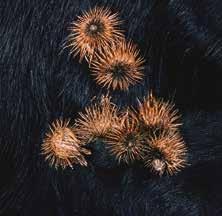
Figure 6 Parasitism Hookworms attach to the inner lining of a human or animal intestine, feeding on passing nutrients. If the host doesn’t eat enough, the worm has been Figure 4 Commensalism Certain plants rely on DRAFT ONLY - NOT FOR SALE passing animals to disperse known to burrow out of the intestines their seeds. The seeds have and travel to other organs, tiny hooks that attach to where significant damage animal fur and will usually can be done. fall some distance from the parent plant.
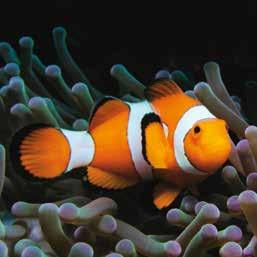
Non-symbiotic relationships
predator an animal that hunts and feeds on another (prey) for food prey an animal that is hunted and killed by another (predator) for food Periwinkle Limpet
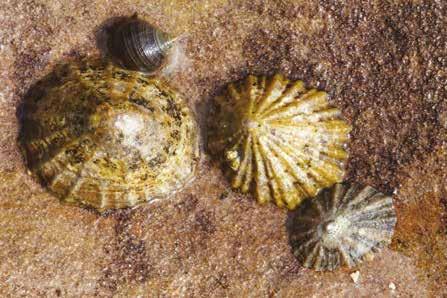
Two non-symbiotic relationships are predator–prey relationships and competition.
In a predator–prey relationship, one organism (the predator) eats another (the prey). Therefore, one benefits and the other is harmed. It is not symbiotic, because the relationship between the organisms is not long term and it only happens when a predator is hungry. Predator species and their prey species have a balanced Numbers of predators and prey Prey Predator
Time Figure 7 A predator–prey graph. The scales aren’t shown but the prey numbers are mostly greater than those of the predators. Notice that the increase and decrease in prey numbers usually comes before the increase and decrease in predator numbers. relationship. If all the prey are eaten, then the predators will starve. A graph of predator–prey numbers (Figure 7) shows a typical pattern. Competition may also exist between members of different species that share a resource such as food (Figure 8). Inhibition is a particular type of competition that occurs when one organism produces a chemical that directly inhibits or blocks the growth and development of another (Figures 9 and 10). DRAFT ONLY - NOT FOR SALE
Figure 8 A black periwinkle (Nerita) competes for food with the limpet (Cellana) on a rock platform – both species feed on algae growing on the rocks. The periwinkle moves faster but does not eat all the algae in its path, so both can survive because the periwinkles usually leave some algae behind for the limpets. However, when the periwinkles are removed, the limpet population increases.
Figure 9 Penicillium fungus mould (seen here growing on an orange) produces an antibiotic called penicillin that inhibits the growth of many species of bacteria. Figure 10 The Lantana plant was introduced into Australia and has become a weed. It releases a chemical into the soil that inhibits the growth of native plant species.
Remember and understand 1 Define symbiosis. 2 Explain why a large plant that produces a lot of shade prevents smaller plants from growing. Apply and analyse 3 Describe an example of the following relationships. a predator–prey b mutualism c commensalism d parasite–host 4 Contrast (the similarities and differences between) a predator–prey relationship and parasitism. 5 Some eucalyptus trees have mistletoe plants living on them. Mistletoe has very similar leaves to eucalyptus leaves.
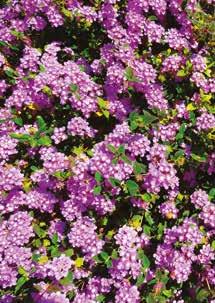
Mistletoe can make its own food, but the stems send suckers into the eucalypt to obtain water and minerals. If too much water and minerals are removed, the eucalypt can die. Identify the type of relationship that exists between the eucalypt and the mistletoe. Justify your answer (by defining the relationship and matching it to this example). 6 Epiphytes are plants, such as ferns and some orchids, that grow high in the branches of other trees, especially rainforest trees. The epiphytes obtain sufficient light to make their own food, collect water from the moist air and obtain minerals from the decaying leaf litter that they catch at their leaf bases. The tree is not affected by these plants. 2.2 Check your learning DRAFT ONLY - NOT FOR SALE Identify the type of relationship that is described. Justify your answer.
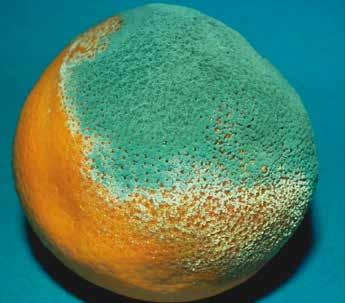
2.3 Population size depends on abiotic and biotic factors
In this
topic, you • All populations in an ecosystem are in dynamic equilibrium. will learn • Populations can decrease due to deaths, emigration and natural disasters.
that:
• Populations can increase due to births and immigration.
The number of organisms in a population can be affected by many factors. Competition for food within a species and between different species can make it difficult for an organism to survive. An increase in the number of predators will cause a population to decrease. A drought or a bushfire can also have long-term effects on a population.
A dynamic balance
All organisms live in a complex web of interrelationships – with each other and with their environment. In an ecosystem, balance needs to be maintained so that all species can exist at their optimum population size. At its simplest, gains due to reproduction and immigration must balance the losses due to death and emigration (leaving; Figure 1). Consider the food web for an ecosystem shown in Figure 2. If the number of frogs decreased in this ecosystem, consequences could include: > an increase in grasshopper numbers, which will cause a decrease in grass > an initial increase in praying mantis numbers because of more grasshoppers > a decrease in lizard numbers > birds eating praying mantises instead of frogs and lizards > a consequent decrease in praying mantis numbers > a further increase in grasshopper numbers and even more loss of grass. If this was severe enough, the ecosystem would be at risk, as it depends on a good supply of grass. The most likely outcome is that the bird population would decrease, so all species would return to balance with reduced population sizes.
A positive effect is that decreased bird numbers might enable the frog population to recover.
emigration when an organism leaves an ecosystem migration the movement of a single organism or a population from one ecosystem to another Births
Ecosystem balance is a type of dynamic equilibrium. Although change may upset the equilibrium, another equilibrium becomes established. Often, it is not greatly different from the original. Changes in ecosystems occur naturally but they may be intensified by external factors such as floods and bushfires. Emigration when Deaths Reproduction, death, migration, natural food source declines events (such as seasonal changes), disasters (floods, droughts, earthquakes) and human intervention occur regularly. Population dynamics Population dynamics is the study of changes in population numbers within ecosystems. If scientists have an approximate idea of how
Immigration Population size Figure 1 The size of a galah population in a particular area depends on the food available and the number of births and deaths.
Figure 2 A food web for an ecosystem Grass Grasshopper Praying mantis Bird Frog Lizard Video 2.3 Fieldwork DRAFT ONLY - NOT FOR SALE
many of each species are in a certain location, they can make predictions and take certain precautions to conserve species.
Regular sampling provides information about increases and decreases in population numbers, and causes can be identified. Counting organisms There are a number of ways to determine the size of a population. The simplest way would be to count all the organisms, but in practice this is rarely possible. It is easier to estimate the total population by counting a sample from a helicopter, or by using quadrats or capture–recapture methods. For human populations, a census is the usual method.
For plants and stationary animals, quadrats (randomly selected square plots) are marked in an ecosystem (Figure 3). The organisms in each plot are counted, an average is obtained and then (knowing the total area of the ecosystem) the estimated number of organisms in the ecosystem is calculated. This method works well if a large number of quadrats are used and the organisms are evenly spread throughout the ecosystem.
For animals that are moving, capture–recapture is a popular method. Animals are captured in traps and marked with tags, correction fluid or permanent marker on their tails.
The number counted on the first capture is N1. The animals are then released and it is assumed that they disperse evenly throughout the population. Another capture (recapture) is made one or two days (or nights) later.
Worked example 2.3: quadrat a randomly selected square Calculating plot used to estimate the population size number of organisms Scientists wanted to determine the size of a bilby population in a small reserve. They used the capture–recapture method to estimate the size of the population.
They captured and marked 9 bilbies on the first night and 8 bilbies (4 marked) one week later.
Calculate the size of the bilby population. Solution N1 = 9 N2 = 8 M2 = 4 Estimated number of bilbies = N1 × N2 ÷ M2 = 9 × 8 ÷ 4 = 18
The number of animals in this second capture that are marked are counted (M2), as well as the total number caught in the second sample (N2). An estimate of the population is then obtained using the following formula:
Total number of animals = N1 × N2 ÷ M2
Worked example 2.3 shows how to use the formula to calculate population size.
Capture–recapture is a suitable technique for estimating the population size of small Figure 3 Using a quadrat Australian mammals, such as the marsupial Antechinus (the common bush rat). Because most native Australian mammals are nocturnal, the traps may be set at night and checked the next morning. capture–recapture a method of estimating the number of organisms in an ecosystem by capturing, marking and releasing a sample of the organisms Remember and understand 1 Describe suitable methods for estimating the size of populations of: a plants and stationary animals b other animals. 2 Describe the advantages and disadvantages of each of the methods you described in question 1.
Apply and analyse 3 Students on a field trip with a national park ranger set traps for a small nocturnal marsupial,
Antechinus stuartii, in a heathland ecosystem. They captured 8 animals on the first night and marked white dots on their tails. Then they released them. On the second night they captured 10 animals, 4 of which were marked. a Calculate the estimated population size of A. stuartii in this ecosystem.
b Describe one way the students could increase the accuracy of this experiment. Evaluate and create 4 Evaluate whether growth in population size is always desirable (by discussing the advantages 2.3 Check your learning DRAFT ONLY - NOT FOR SALE and disadvantages of continuous growth, and deciding whether the advantages are more important than the disadvantages).
2.4 Introducing a new species may disrupt the balance in an ecosystem
In this
topic, you • An organism introduced into an ecosystem can consume the resources of other will learn native organisms. that: • An ecosystem needs to establish a new equilibrium after the introduction of a new species. • Biological control involves the deliberate introduction of an organism that will control or decrease the population of a non-native plant or animal. All ecosystems are in a precise balance that ensures enough food and resources to support the community of organisms. Introducing or removing a species from an environment can disrupt this balance and have devastating effects on other populations in the ecosystem. Introducing rabbits European rabbits were brought to Australia on the First Fleet in 1788. The 250-day journey ensured that the rabbits were well domesticated by the time they arrived here. The rabbit population around Sydney did not grow very quickly. However, when the rabbits were introduced into Tasmania, populations of thousands quickly became established.
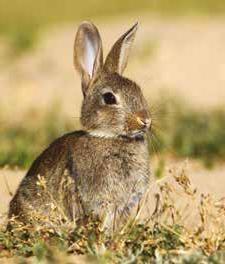
Rabbits breed very quickly. A single female rabbit can have up to 14 babies in each litter. If the average female rabbit produces one litter a month, and these new babies are able to breed within six months, the population can grow rapidly (see Figure 2). Rabbits for hunting In 1859, farmer Thomas Austin received 24 wild rabbits from England, along with partridges, hares and sparrows, for hunting. These were released near Geelong. This time the rabbits were better equipped to survive. In England, the winters were very cold and these abiotic (non-living) conditions slowed the growth of rabbit populations there. 40 000 60 000 80 000 100 000 120 000 140 000 160 000 Number of rabbits Figure 1 Rabbits have had a devastating effect on ecosystems in Australia. DRAFT ONLY - NOT FOR SALE
20 000
0
0 1 2 Year 3 4
Figure 2 The potential growth of a rabbit population over four years from a single female rabbit (assuming unlimited food and no predators).
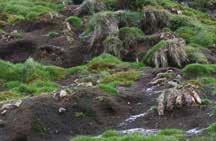
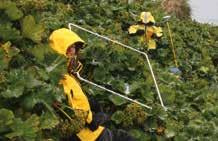
In Australia, the winters were much warmer and the clearing of the scrubland created large areas of farmed grasses for food. There were also few predators of rabbits. Over the next 40 years, the rabbits spread as far Figure 4 Rabbits bite tusks of grasses very close to the ground. Combined with digging extensive burrows, this makes the soil more prone to erosion. populations on the island. However, when the cats were killed, the island rabbit population increased dramatically, destroying native plants and affecting many other organisms that were native to the island. Scientists needed to find a way to control the rabbits. Figure 3 Completed in 1907, a rabbit-proof fence was built between Cape Keraudren and Esperance in Western Australia. as Queensland, Western Australia and the Northern Territory. Controlling the rabbit population By 1887, rabbits were causing so much damage to the environment that the New South Wales government offered a reward for any new method to decrease the population. Rewards were offered for each rabbit killed, and a rabbitproof fence across large sections of Western Australia was trialled (Figure 3). The increase in the rabbit population had a large impact on the local ecosystems. The rabbits competed with the local marsupials for food and destroyed large sections of the habitat with their burrows (Figure 4). Predators of the rabbits (such as dingoes and eagles) grew in numbers due to the increase in food. Unfortunately, these increased numbers of predators also ate the local marsupials, causing those populations to decline. All these factors contributed to the permanent loss of several species of native plants and animals. a b DRAFT ONLY - NOT FOR SALE
Macquarie Island rabbits
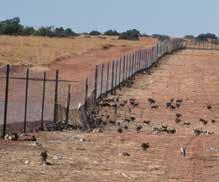
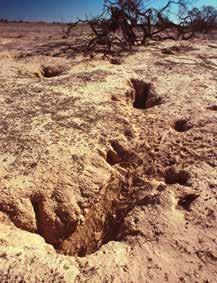
In 1985, scientists on Macquarie Island (halfway between Australia and Antarctica) devised a plan to eradicate the cats that had been introduced to the island since the early nineteenth century. It was thought that this would increase the native burrowing bird
Figure 5 a Before: This slope on Macquarie Island had vegetation as recently as 2007. b After: The same slope a few years later – it has been ravaged by rabbits since cats were eradicated. OXFORD UNIVERSITY PRESSNo part of this publication may be reproduced, CHAPTER 2 ECOSYSTEMSstored in a 27 retrieval system or transmitted in any form or by any means.
Biological control
All efforts to control the rabbit population by physical means were unsuccessful. In 1938, CSIRO scientists studied a way to control the disease using a living organism (biological control). They tested a virus called Myxoma for its ability to cause disease in rabbits. This virus causes a disease with symptoms including fever and swelling around the head of the rabbit. Death occurs within 14 days. Myxoma was eventually released in the wild and quickly killed almost all the rabbits that caught the infection. This increased Australia’s wool and meat production within two years. However, a small percentage of rabbits were unaffected by Termites
Echidnas Eucalyptus trees
Wattle trees Grasshoppers Kookaburras
Kangaroos Wombats
Frill-necked Rabbits lizards
the disease. These rabbits survived and bred a new population of rabbits that were immune to the disease. New viruses, such as the rabbit calicivirus, have been tried, with similar results. Dingoes Before a species is introduced as part of biological control of pests, scientists must model the possible effects on populations that compete for the same food source or the predators that may prey on them. Scientists must effectively map the food web of the ecosystem and how the balance between all organisms in the community will be affected by the introduction of the biological control organism. biological control a method of controlling a population by releasing a living organism (a parasite or consumer) into an ecosystem disease a disorder or condition that interrupts the normal functioning of an organism immune able to fight an infection as a result of prior exposure DRAFT ONLY - NOT FOR SALE
Grasses
Figure 6 Rabbits compete with grasshoppers, wombats, kangaroos and termites for grass.
2.4 Check your learning
Remember and understand Evaluate and create
1 Explain why rabbits are referred to as an introduced animal in Australia. 2 Identify two reasons why the rabbit population was able to increase so quickly when introduced to Australia. 3 Define the term ‘biological control’. Apply and analyse 4 Use the food web in Figure 6 to identify two populations that would increase as a result of the introduction of rabbits. 5 Explain the effect a large rabbit population would have on the ecosystem in Figure 6. 6 Explain why Myxoma is no longer effective in controlling rabbit populations.
7 Evaluate the ethics of using biological control of rabbits, by: • describing how Myxoma infection affects the health of a rabbit • describing the effect a large rabbit population has on a native environment, including the native plants and animals • describing how a large rabbit population affects our ability to grow food • deciding whether the life (and Myxoma-related death) of a rabbit is more or less important than the effects you described above. (Does the end justify the means?) Figure 7 Plants are an important part of an ecoystem. DRAFT ONLY - NOT FOR SALE
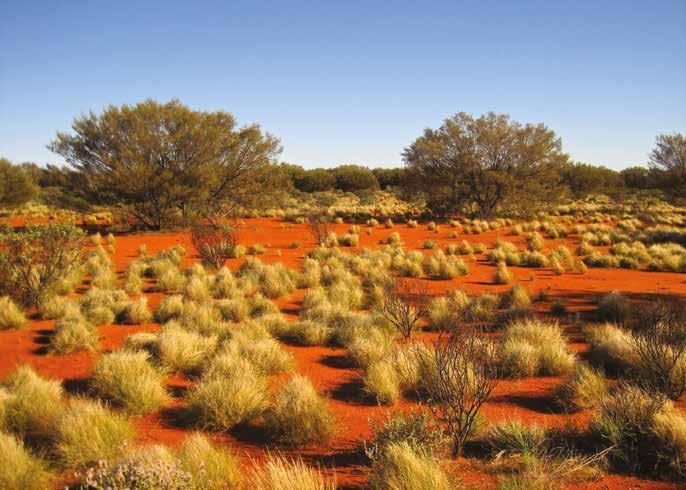
2.5 Energy enters the ecosystem through photosynthesis
In this
topic, you • Photosynthesis and chemosynthesis are the original source of energy in an will learn ecosystem. that: • Photosynthesis is the transfer of light energy from the Sun into chemical energy in glucose. • Carbon dioxide and water react in the presence of light energy to produce oxygen and glucose. • Excess glucose is stored as starch. Ecosystems rely on the transfer of energy from one part to another. The first source of energy in most ecosystems is solar energy via photosynthesis. Animals cannot directly use energy from the Sun. Even in caves and other places where there is no light, the energy may be from dead plants and animals, which originally obtained their energy from the Sun. An exception is chemosynthetic bacteria on the ocean floor and in the craters of volcanoes – these bacteria trap the energy from chemicals and chemical reactions occurring under the Earth’s crust. What is photosynthesis? Living things need energy to grow and repair, to defend themselves, and to move around. The energy in an ecosystem usually originates from the Sun. Plants, some algae and some bacteria are able to transform this light energy into chemical energy through a process called photosynthesis. In this process, water and carbon dioxide are converted into glucose (a sugar), oxygen and energy. The overall equation for photosynthesis is:
Figure 1
Photosynthesis occurs inside chloroplasts. The image shows a cross-section of two chloroplasts, seen through an electron microscope. photosynthesis a chemical process used by plants to make glucose and oxygen from carbon dioxide, sunlight and water
carbon dioxide + water → glucose + oxygen + water 6CO2 + 12H2O → C6 H12O6 + 6O2 + 6H2O Outer membrane Granum (stack of thylakoids) Stroma lamella Video 2.5A Photosynthesis Video 2.5B What is photosynthesis? DRAFT ONLY - NOT FOR SALE Lumen (inside of thylakoids)
Inner membrane Stroma (aqueous fluid) Thylakoids
Figure 2 The structure of a chloroplast
Where does photosynthesis happen?
Figure 4 Starch can be stored in roots and tubers of plants. During the night there is no sunlight for photosynthesis, but plants still need energy to stay alive. Plants break down starch into glucose so that they can survive at night. 2.5 Check your learning
Remember and understand 1 Identify where the process of photosynthesis occurs in a plant. 2 Identify the chemicals that are used in the photosynthesis reaction. 3 Describe how the chemicals needed for photosynthesis enter a plant.
Apply and analyse 4 Draw a flow diagram summarising the inputs and outputs of photosynthesis. 5 Identify two plant foods that we eat because they are sources of starch.
Evaluate and create
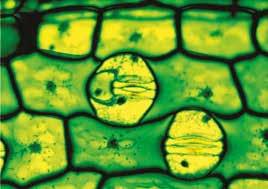
chlorophyll a green pigment in chloroplasts that absorbs On average, a plant leaf has tens of thousands of solar energy, which is used cells. A single cell contains 40–50 chloroplasts, by plants in photosynthesis which contain the green pigment chlorophyll. stomata Chlorophyll captures the Sun’s light energy and small holes in a plant leaf uses it in the formation of glucose. surrounded by guard cells that control their opening
Plants do not breathe the same way we and closing; singular ‘stoma’ do. Instead, they take in the carbon dioxide needed for photosynthesis through microscopic starch a complex form of sugar pores called stomata (singular ‘stoma’) in that is found in certain the leaves (Figure 3). The water needed for foods (e.g. bread, potato photosynthesis enters through the roots and Figure 3 Guard cells open and close the stomata and rice) travels to the leaves, where the glucose is made of a plant. in the chloroplasts. Factors that affect photosynthesis Many factors can affect the rate of photosynthesis. If there is not enough light, photosynthesis cannot occur. This can be a problem for young plants trying to grow on the floor of a rainforest. The taller plants compete with them for light. Water is also needed for photosynthesis. In the desert, the lack of rain can restrict the amount of photosynthesis, and therefore the amount of glucose produced. What happens to the glucose? Plants are sugar factories, making millions of glucose molecules during daylight hours. Plants require a constant supply of glucose for energy to grow and to repair damage. In daylight, more glucose is made than can be used directly by the plant, so excess glucose is stored in the form of starch and other carbohydrates in the roots, stems or leaves of the plant. Some plants store starch in underground storage organs, such as roots and tubers (for example, potatoes, carrots and parsnips all store starch in this way).
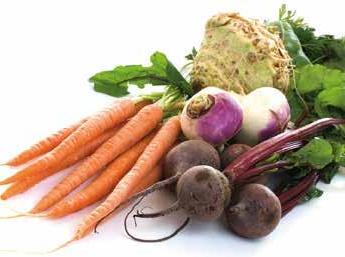
Stoma Guard cells DRAFT ONLY - NOT FOR SALE
6 ‘Photosynthesis is the most important metabolic process on Earth.’
Evaluate the above statement by: • describing why photosynthesis is important in an ecosystem • describing what would happen if photosynthesis was not able to occur • deciding whether the statement is correct.
2.6 Energy flows through an ecosystem
In this
topic, you • The energy in glucose is used for movement, growth and repair of an organism. will learn • The energy in glucose molecules must be converted to ATP in a process called that: cellular respiration. • Only 10 per cent of the energy is passed on to the next level in a food chain. • Waste energy in the form of heat is produced. Living systems continuously take in energy from the Sun. When one organism eats another, it takes the energy that was stored in the food’s cells and tissues. Of this stored energy, 90 per cent is transformed into movement, or the growth and repair of the animal’s own cells. This transformation of energy produces a by-product: heat energy. Of all the stored energy that is consumed, only 10 per cent is available to eventually be passed from one organism to the next in a food chain (Figure 1). This means the energy in an ecosystem needs to be constantly replaced (by plants capturing sunlight), as most of it is released as unusable heat energy. Worked example 2.6 shows how to calculate energy in an ecosystem. 1 unit of energy 10 units of energy 100 units of energy 1000 units of energy Top consumer Secondary consumers Primary consumers Producers Heat
Heat Heat Heat Video 2.6A Ecosystem energy transfer Video 2.6B Cellular respiration equation DRAFT ONLY - NOT FOR SALE 33300 energy units Sun
Figure 1 The movement of energy along a food chain can be represented by an energy pyramid. The size of each trophic level represents the amount of energy being passed on to the next level in the food chain.
Energy for work
Energy transformations are an essential part of the metabolic processes (chemical reactions that keep cells working) that keep an organism alive. We can describe these processes as the ‘work’ of living organisms. Some of the types of ‘work’ performed by living organisms are shown in Table 1. Table 1 The ‘work’ of living organisms Type of work Examples
Building compounds All organisms use energy to build and replicate molecules so they can manage metabolic processes, grow and pass information on to offspring.
Communication inside an organism Energy is needed for communication within and between cells. Electrical energy and chemical energy are used when nerves transmit information throughout the body.
Physical movement Energy is supplied for physical movement, such as movement of leg or arm muscles, and involuntary movement, such as contraction of the heart. In plants, energy is used for movement towards sunlight.
Transport Energy is required to move nutrients and wastes throughout an organism’s body. Electrical potential energy is needed to transport materials into and out of cells. Figure 2 Energy transformations are vital to keep plants growing.
Worked example 2.6: Calculating energy in an ecosystem
If 2000 energy units (joules) were eaten by the grasshopper in Figure 1: a calculate the number of joules available to be used by a frog that ate the grasshopper b identify how the remaining energy was used. Solution a Only 10% of the energy in an organism is passed on to the next level of the food chain.
Energy passed on to the frog = 10% of 2000 joules = 10 100
× 2000 = 200 joules The frog would receive 200 joules of the 2000 joules eaten by the grasshopper. b The remaining 1800 joules would have been used by the grasshopper for moving, growing and repairing damage to its body. The chemical reactions in these processes produce the heat DRAFT ONLY - NOT FOR SALE energy that is released into the environment.
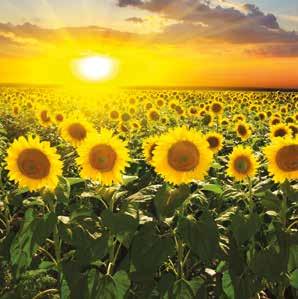
What is cellular respiration?
A closer look at cellular respiration
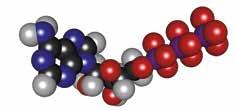

Whenever we burn a fuel, such as wood or oil, we release the energy that has been chemically stored in the molecules. This energy in the fuel molecules is organised, or ordered, because it is tied to the molecule. Burning requires oxygen and is a rapid process, releasing the energy as heat energy. Carbon dioxide and water are also produced. Cellular respiration is similar to burning. Glucose is the molecule that our body uses for fuel. Each cell uses oxygen to ‘burn’ glucose and convert the energy into ATP (adenosine triphosphate). ATP is much easier for our bodies to use for energy. Fats and proteins can also be converted into ATP in cellular respiration. Oxygen is used during cellular respiration, and carbon dioxide and water are waste products. Because oxygen is needed for this aerobic respiration process, it is often called aerobic respiration. the second step in the The process occurs in the mitochondria of breakdown of glucose to all plant and animal cells. carbon dioxide and water; occurs in the mitochondria when oxygen is present and produces 34 ATP molecules mitochondrion an organelle of a cell, where energy is produced (plural: mitochondria) glycolysis the first part of cell respiration in which glucose is broken down to produce energy
The energy stored in the chemical bonds of glucose (C6H12O6) is transferred into ATP during cellular respiration. The general equation for cellular respiration is: Reactants Products glucose + oxygen → carbon dioxide + water + energy C6H12O6 + 6O2 → 6CO2 + 6H2O + 36ATP The breakdown of glucose to carbon dioxide and water occurs in two major steps. 1 Glycolysis occurs in the cytoplasm and produces 2 ATP molecules and pyruvate. 2 Aerobic respiration occurs in the mitochondria in aerobic conditions (when oxygen is present). It produces 34 ATP molecules. When we exercise, our muscle cells can run out of oxygen for aerobic respiration. The cells switch to producing energy anaerobically (without oxygen) and lactic acid is produced as a waste product. This does not produce as much ATP energy as aerobic respiration, which is why our muscles feel weaker. In yeast cells, anaerobic respiration (known as fermentation) produces alcohol and carbon dioxide. Figure 3 An ATP (adenosine triphosphate) molecule. ATP is the energy currency of organisms. DRAFT ONLY - NOT FOR SALE
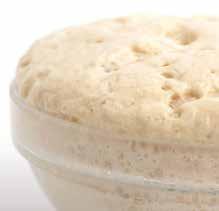
Figure 4 The fermentation of yeast produces carbon dioxide, which makes bread rise. Figure 5 When we exercise, cells produce energy without oxygen, which is why our muscles feel weaker.
Photosynthesis and respiration
Remember and understand 1 Explain why plants undergo aerobic respiration. 2 Explain why cellular respiration is constantly occurring in cells (by identifying the key product of the reaction and what the organism uses this molecule for). 3 Identify the two main steps of respiration. 4 Identify the location of cellular respiration in cells.
Photosynthesis and respiration are effectively the opposite of each other. Photosynthesis traps light energy from the Sun, converting it into the chemical energy of glucose. Respiration Light energy ECOSYSTEM Photosynthesis in chloroplasts CO2 + H2O Organic molecules + O2 Cellular respiration in mitochondria ATP is the energy source for most cellular activities Movement and heat energy Figure 6 Unlike matter, which is recycled in an ecosystem, energy flows in one direction only, entering as sunlight and leaving as movement and heat. 2.6 Check your learning Apply and analyse 5 Compare (the similarities and differences between) cellular respiration and photosynthesis. 6 If a plant converts 50 joules of energy in photosynthesis, calculate the amount of energy a herbivore will obtain when it eats the plant.
moves the energy out of glucose and into ATP, which can then be used by cells. Many of the molecules in the two reactions are the same, but they are part of different pathways. Glucose is a product of photosynthesis, whereas it is a reactant in respiration. DRAFT ONLY - NOT FOR SALE
2.7 Matter is recycled in ecosystems
In this
topic, you • Matter cannot be created or destroyed, which means it must be recycled. will learn • The carbon cycle describes how carbon atoms cycle through an ecosystem.
that:
Cycles of matter Matter (made up of atoms) cannot be created or destroyed. This means matter must be recycled. The cycling of matter from the atmosphere or the Earth’s crust and back again is called a biogeochemical cycle (bio means ‘living’; geo means ‘earth’). Plants absorb simple molecules such as carbon dioxide, water and minerals, and convert them into sugars by photosynthesis. Animals eating the plants use the sugars and other molecules. When plants and animals die, the molecules in the matter are rearranged by decomposers to obtain energy. Decomposers are essential to the cycles of matter – they break down the molecules in dead organisms and convert them into simple molecules that can be reused by plants.
Scientists will often follow particular molecules or atoms as they cycle through the environment, to establish the health of the ecosystem. Water cycle The global water cycle is driven by heat from the Sun. Three major processes driven by solar heat are precipitation (rain, snow, sleet), evaporation and transpiration from plants. These processes continuously move water between land, oceans and the atmosphere. On land, the amount of precipitation is greater than the amount of evaporation/transpiration, and the excess water feeds lakes, rivers and groundwater, all of which flow back into the sea. Humans can alter the water cycle. For example, cutting down rainforests changes the amount of water vapour in the air (due to transpiration), which alters precipitation. precipitation the process in which water vapour in the upper atmosphere becomes liquid water in the form of rain, snow or sleet and falls to the ground evaporation a change in state from liquid to gas; also a technique used to separate dissolved solids from water transpiration the process of water evaporating from plant leaves; causes water to matter anything that has space and volume; matter is made up of atoms Figure 1 Logging of rainforests can affect precipitation. Water stored in the atmosphere Precipitation Water stored in ice and snow Evaporation Water stored in the oceans Surface run-off Interception lossTranspiration Sublimation Condensation Fresh water stored in rivers, lakes, streams and ponds Snow melt runoff to streams DRAFT ONLY - NOT FOR SALE move up through the plant from the roots In ltration Groundwater discharge
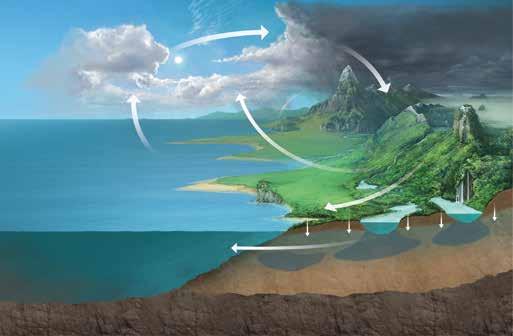
Groundwater stored beneath the Earth’s surface
From volcanoes
CO2 released into atmosphere by respiration and decomposition Figure 3 The carbon cycle
Burning
Remember and understand 1 Define the chemical term
‘matter’. 2 Describe how matter moves through an ecosystem. 3 Explain what is meant by the term ‘carbon cycle’. 4 Describe three ways carbon dioxide can be released into the environment. 5 Describe two ways carbon dioxide can be removed from the atmosphere.
Water is not available equally in all ecosystems. Water that has evaporated from an ocean may later fall as rain on a forest thousands of kilometres away. Australia is an example of this situation: some areas may be in drought and others may have floods, and organisms in ecosystems in both areas may be affected by disruption of the water cycle. Carbon cycle Carbon atoms are found as carbon dioxide in the air and in compounds such as sugars, proteins and lipids (such as fats) in the bodies of living organisms. Globally, the return of 2.7 Check your learning carbon dioxide to the air by respiration is balanced by its removal in photosynthesis. Apply and analyse Other ways of returning carbon dioxide to the 6 ‘You are eating the same atoms air include the burning of fossil fuels, bushfires that were in dinosaur poo!’ and the decomposition of dead matter. The Evaluate the accuracy of natural balance of this cycle is disturbed by this statement (by describing excess burning, which contributes to the how matter moves through enhanced greenhouse effect (see Topic 2.9). an ecosystem, describing how Termites recycle carbon the atoms in dinosaur poo will change over time and deciding Plant cell walls are made of cellulose, a complex whether the statement is molecule that is insoluble in water and does correct). not break down easily. Fungi are able to break 7 Contrast (the differences down cellulose and play a major role in the between) the flow of energy decomposition of wood, but they require a in an ecosystem and the flow moist environment, such as can be found of matter in an ecosystem. in a rainforest. In drier areas of Australia, such as forests and woodlands in tropical and subtropical areas, as well as savannah grasslands, termites have a major role in the decomposition and recycling of carbon. Termites are social insects and live in nests. You may have seen termite mounds in drier parts of Australia (Figure 4). Micro-organisms in the guts of termites break down the cellulose of plant material such as grasses, plants and wood. Scientists have estimated that termites recycle up to 20 per cent of the carbon in ecosystems such as savannah grasslands.
Respiration, burning, decay enhanced greenhouse effect an increase in carbon dioxide and other heatcapturing gases in the atmosphere, resulting in increased warming of the Earth
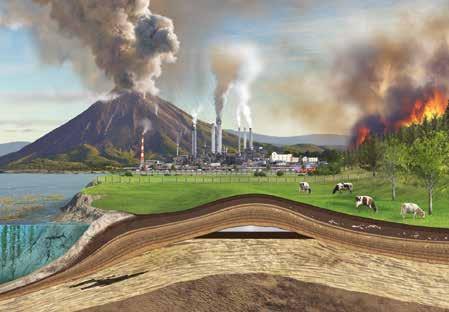
Oxygen Carbon dioxide given off dissolved in rainwater Photosynthesis Released in daylight from soil Respiration Igneous rocks eroded to sedimentary rock
Carbon compounds in plants New fossil beds Limestone Petroleum Hard water Limestone Ocean absorbs CO2 as carbonic acid Coal Carbon compounds in animals Marine animals Figure 4 A termite mound in the savannah of northern Australia DRAFT ONLY - NOT FOR SALE
2.8 Natural events can disrupt an ecosystem
In this
topic, you • The size of a population will increase and decrease as a result of many natural events. will learn • The limitation of resources, presence of predators, migration and emigration will that: all affect population numbers. • Natural disasters such as drought, floods and bushfires will cause changes throughout the ecosystem. • Some plants and animals have adapted to cope with bushfire. Limiting resources As the size of a population reaches its maximum carrying capacity (ability of the environment to support it), some of its resources, such as food, space and shelter, will become limited. This means some organisms will not have access to these resources and will either die or emigrate (leave). When this occurs, the population will stabilise (reach its maximum size). Once the population decreases, there will be enough resources for those remaining. The population will remain in balance, or equilibrium. Seasonal changes When the weather becomes colder, many animals migrate to warmer areas. As a result, their populations decrease in one environment and increase in another. During the breeding season, usually spring, the numbers of animals increases. Flowering plants are pollinated and form seeds that spread throughout the environment, and later germinate. As the population increases, so does competition for resources. Some of these resources can become limiting factors (factors that can affect the survival of an organism). As a result of this competition, some members of the population survive and others die, allowing the population to maintain its balance.
Natural disasters Australia has a widely fluctuating environment. Years of drought have been mixed with torrential rains and flooding. When extreme natural change affects humans, we call these changes natural disasters. Impacts of floods and droughts Floods are an overflow of water onto dry land, which has an immediate effect on the growth of plants and the germination of seeds. This is particularly noticeable after a drought, during which plants have managed to survive and seeds have remained dormant. Marine ecosystems do not benefit from floods on land. Run-off brings sediment, pesticides and fertilisers into the marine ecosystem, causing some algal species to dominate the environment. Floods can be a hazard for some animal life. Small mammals often escape to higher ground. Snakes are flushed out of their cover, as witnessed in the 2011 Queensland floods, and can be a potential danger to humans. Aquatic animals benefit enormously from floods. Fish can breed in water bodies such as lakes. Water birds then have an abundance of fish, insects and waterweeds as sources of food, and they can breed in great numbers, temporarily changing the balance in populations. Droughts pose an even greater challenge carrying capacity the maximum number of organisms in a population that can be sustained by an ecosystem DRAFT ONLY - NOT FOR SALE than floods. During a drought, animals Figure 1 Short-tailed shearwaters leave their migrate elsewhere and manage to survive until burrows on Montague Island on the southern coast conditions have improved. Some populations of New South Wales and fly to feeding grounds in the ‘hang on’ during drought, but other ecosystems area of the Bering Sea (between Russia and Alaska) during the northern hemisphere summer. They return to breed in are severely affected. For example, extremely late September. dry topsoil was blown from central Australia
Remember and understand 1 Define the term ‘carrying capacity’. 2 Identify two animals (not birds) that migrate due to changing seasons. 3 Describe one way an animal might survive a bushfire. 4 Describe two ways a plant may have adapted to surviving a bushfire.
Figure 2 Flooding in Queensland in 2011 to Melbourne and Sydney in recent years. This erosion removed essential nutrients for many plants, animals and agricultural ecosystems. Impacts of bushfires on ecosystems Bushfires destroy both plant and animal life. Many native Australian plants are adapted for fire resistance and tolerance, and may actually rely on fires to complete their life cycles. For example, wattle seeds will only open when exposed to heat and moisture. These adaptations include: > thick bark that insulates and protects the growing and transporting tissue inside the trunk (stem; see Figure 6) > epicormic buds beneath the bark that can regenerate the branches when the fire has passed (Figure 7) > lignotubers within the roots that can grow into new shoots after fire (Figure 8). 2.8 Check your learning Apply and analyse 5 Identify one long-term effect on plants of a: a drought b bushfire c flood. 6 In relation to resources in an ecosystem, describe what the term ‘limiting’ means. Contrast (the differences between) ‘limiting’ and ‘limited’.
Figure 3 Drought poses a great Figure 4 The bushfires across threat to life. Australia in 2020 devastated epicormic bud entire communities and put a small growth beneath the wildlife at risk. bark of a plant that allows regeneration after a fire lignotuber a small growth in the root of a plant that allows regeneration after a fire
Figure 5 Lack of foliage means a lack of food and shelter for animals. Figure 6 Native Australian trees have thick bark to protect them from fire. Figure 7 Epicormic buds beneath bark can regenerate branches after fire. Most Eucalyptus species have epicormic buds and lignotubers. While some plants are well adapted, other species of plants do not survive. This can result in the permanent loss (extinction) of the species. Like plants, some animal populations in fireprone areas are tolerant of fire. These species can sense fire and escape to other areas or into underground burrows. The most vulnerable are small invertebrates and insects at the larval stage. Even if they survive the fire, many animals will need to migrate away from the environment. The change in the vegetation and the soil conditions alters their food supply and sheltering options. The loss of shelter increases the risk of predation in some cases. Animals may not return to the area for a long time. DRAFT ONLY - NOT FOR SALE Figure 8 Lignotubers within roots grow into new shoots after fire.
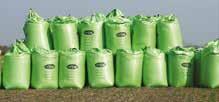
2.9 Human activity can disrupt an ecosystem
In this
topic, you • Humans compete with other organisms for resources. will learn • Water is an essential resource for all organisms.
that:
• Human-generated pollution can affect the survival of other organisms. • Humans are responsible for the enhanced greenhouse effect. Humans can have a significant short-term or long-term impact on the well-being and survival of other species. We compete with plants and animals for resources. We change the ecosystem by removing vegetation, increasing erosion of topsoil and causing global warming. Competition for resources In 2021 the world’s human population was approximately 7.8 billion and it is predicted to rise to about 9.9 billion by 2050. This will cause an increased demand for food, which means more pressure on the natural resources of the land and sea. These resources may be needed by other species. For example, when water is used to irrigate farms that produce food in the Murray River Basin, this means there is less water for the ecosystems downstream. As a result, the river red gum forests that surround the Murray are placed under extreme stress during droughts. The lack of water flow has also resulted in the build-up of dirt and silt along the banks of the waterways, preventing further flow of fresh water that is needed by plants and animals downstream. Humans are also responsible for the permanent removal of trees and plants from bushland. Before European settlement, fallen trees were used as food or shelter by local animals. Removal of these trees makes these animals vulnerable to predators and the extremes of weather. It also removes important matter from the ecosystem, limiting the recycling of matter, which is important to the health of the environment. Pollution Human activity has introduced many unwanted chemicals into ecosystems. Some chemicals can cause sickness and/or death of certain species and, in some cases, can result in the collapse of entire food webs. Many industries now have much more restrictive rules about the chemicals that can be released into the environment. Figure 1 Numbers of Murray cod, and other native fish, have decreased significantly due to irrigation. Some fish have now been declared rare or endangered. Figure 2 Since James Cook sailed into Botany Bay near Sydney in 1770, this ecosystem has become urban because of the many infrastructure changes that have taken place.
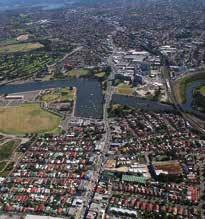
Figure 3 Phosphates in detergents and fertilisers used on agricultural land wash into oceans, lakes, river and other water bodies. This leads to eutrophication – an increase in organisms that reduce oxygen levels in the water, harming other organisms. Enhanced greenhouse effect The Earth is surrounded by a thick layer of gases called the atmosphere. When the Sun shines on the Earth, the ground heats up, which in turn heats the gases in the atmosphere. This heat keeps the Earth warm, just like a glass greenhouse keeps plants warm even in the depths of winter. Some gas molecules (carbon dioxide, water and methane) are especially effective at trapping the heat in this process, Video 2.9 Ask a scientist – Dr Dewi Kirono (climate scientist) DRAFT ONLY - NOT FOR SALE which is called the greenhouse effect. Increasing numbers of humans, increasing wealth and more sophisticated technology have resulted in large quantities of fossil fuels being used for transport, industry, agriculture and electricity. When fossil fuels are burnt, they produce large amounts of carbon dioxide,
increasing the amount of heat that is trapped in the atmosphere. This enhanced greenhouse effect is causing global temperatures to increase.
Remember and understand 1 Describe two ways humans compete with plants and animals for resources. 2 Describe the greenhouse effect. Apply and analyse 3 Contrast (the differences between) the greenhouse effect and the enhanced greenhouse effect. 4 Describe two ways your local ecosystem will be affected by the enhanced greenhouse effect. 5 The green sea turtle lays its eggs in the warm sands of northern
Australia. If the sand is at 29ºC, half the turtles will develop into males and the other half will be females. Below 27ºC, most of the turtles will be male. Above 31ºC, most of the turtles will be female.
Describe the effect that global warming will have on the green sea turtle population. Evaluate and create 6 Currawongs are native birds that thrive in towns and cities because
Ecological effects of climate change Although many humans welcome the thought of warmer weather, small increases in average temperatures can have devastating effects on climate systems (the average temperature, wind, sunshine, humidity and rain that occurs in an area – see Table 1). In mountainous areas, plants and animals that need cooler moist environments to survive are losing their habitats as the snowline retreats higher up the slopes. One such animal is the mountain pygmy possum (Figure 4), which needs a snow depth of at least 1 m to provide enough insulation for hibernation. Less snow means the cycle of hibernation and breeding is disrupted. This will make it difficult for the possum to breed, and could result in it becoming extinct. 2.9 Check your learning they can eat human food scraps and any bird seeds left out by humans. They also hunt smaller birds and drive them out of an area. Evaluate the impact of humans on the bird population in cities (by describing how the currawongs are affected by human populations, and how other birds are affected by human populations, and deciding whether the overall human impact on all birds is positive or negative).
hibernation a state of inactivity of an organism, usually as a result of low environmental temperature
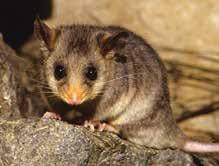
Table 1 Some of the main effects of climate change on ecosystems
Change Effect
Changes in distribution and abundance of species – migration of species north or south, to higher levels or more suitable locations, due to increasing temperatures Extinction of some organisms if they cannot adapt to new climatic conditions
Changes in the number of different types of organisms in ecosystems (e.g. due to species competition for resources or invasion of weeds/pests) Increased weeds and other invasive species (i.e. pests)
Changes in metabolic processes (e.g. cellular respiration, photosynthesis, growth and tissue composition) Changes in life-cycle events (e.g. breeding, migration)
Ocean acidification due to carbon dioxide being converted to carbonic acid in the ocean Increased coral bleaching and destruction of and/or changes to coral reefs
Changes in river flows, sediment formation and nutrient cycles A lack of water, causing extinction and increased toxic algal blooms due to floods
Drying of ecosystems Decrease in coastal mountain rainforests Figure 4 The mountain pygmy possum is listed as an endangered species.
Figure 5 Increased carbon dioxide levels in the atmosphere cause the ocean to become acidic. As a result, the polyps in the coral die, causing bleaching. DRAFT ONLY - NOT FOR SALE
//SCIENCE AS A HUMAN ENDEAVOUR//
Different communities have different views on how to manage their local ecosystems. The ability to see an ecosystem from another’s perspective can be useful. Historical use of ecosystems Aboriginal and Torres Strait Islander peoples have over 60000 years of connection and understanding of their diverse landscapes. They believe they have been on this continent from the Dreaming (day one) and time immemorial. The ‘out of Africa’ model is always changing, especially with new archaeological discoveries and genetics updating their arrival to Australia and their movement through South-East Asia, before arriving in northern Australia. Aboriginal and Torres Strait Islander peoples used (and still use) fire as a tool to shape the landscape while altering plant life cycles and animal adaptations to manage resources. They are farmers who respect the land because it provides them with the resources for life – food, water, shelter and medicine. As the original inhabitants of the land, Aboriginal and Torres Strait Islander peoples were aware of the seasonal nature and life cycles of plants and animals in the ecosystems around them. They were prepared to move to areas where plant and animal foods were available at a particular time or season, or when resources were drying up. Instead of considering the land to be owned by a person or group of people, to be cleared and used according to their needs, Aboriginal and Torres Strait Islander peoples
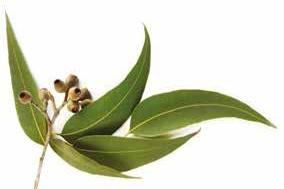
consider land management to be based on shared ownership and custodianship with a deep respect for the land. As Indigenous Person of the Year 1999, Bob Randall said, ‘We do not own the land. The land owns us’. Cool burning, firestick and cultural burning There is increasing recognition and interest in the Aboriginal and Torres Strait Islander peoples’ use of ‘cool burning’ to control fuel loads and suppress out-of-control bushfires while reducing the emission of greenhouse gases. This is important, with Australia predicted to become hotter and drier under climate change and the increase of catastrophic bushfires, as this knowledge can play a part in managing the landscape. The advancement of knowledge and teachings by Aboriginal and Torres Strait Islander fire practitioners has the idea that the right fire can only have effect through reading country. The Aboriginal and Torres Strait Islander ancestors never burnt every ecosystem, otherwise this would decrease ecosystem biodiversity and resources while releasing carbon into the atmosphere. Early in spring and sometimes at night, with low wind, the grasses are not as dry. Any fires burn slowly and are put out by the heavy nighttime dew. This means small fires can be lit to reduce the grasses that form the undergrowth under treetops or canopies. If small patches of undergrowth are burnt, the nutrient matter is recycled back into the soil without destroying Human management of ecosystems continues to change 2.10 DRAFT ONLY - NOT FOR SALE all the food available. This cool burning process has been used by Aboriginal and Torres Strait Islander peoples for thousands of years, and many plants, such as the grass tree (Xanthorrhoea sp.), have Figure 1 Cool burning promotes new evolved to flower only when the base of the tree plant growth. has been burnt by fire.
11 000
$14 Volume of water applied to irrigated 10 000 9000 8000 7000 6000 agriculture (GL) Gross value of irrigated agricultural production (right axis) $9 $10 $11 $12 $13 5000 $8 Figure 2 Modern farming involves using water more wisely.
If cool burning is repeated each year, the slow limited burning reduces the release of greenhouse gases (especially methane and nitrous oxide) and the carbon remains trapped in the unburnt large trees and bushes. Modern needs As the population of Australia has increased, so too has the need for food. This need must be balanced with maintaining the biodiversity of the unique Australian ecosystem.
In Australia, we currently have plenty of food, thanks to a strong agricultural community. Irrigation of large areas ensures Figure 3 Scientists are that the crops are able to survive. As shown in developing ways to use Figure 2, Australian farmers have become more water more efficiently. effective in their use of water, protecting this a Traditional irrigation important resource for future generations. b Modern microirrigation system
In 2018, tropical Cyclone Debbie hit the coast of Queensland, causing major property damage, power outages and millions of dollars of damage to Australia’s sugar-cane industry. Global warming is expected to cause storms of this magnitude to become more frequent and
Volume of water applied to irrigated agriculture (left axis) Gross value of irrigated agricultural production (billion) 2003 2004 2005 2006 2007 2008 2009 2010 2011 Year spread over larger areas. Some scientists predict that droughts may also become increasingly frequent in all areas of Australia. This will have an impact on the types of crops that can grow in many areas. In 2010, Australia’s chief scientist made some recommendations to enable us to maintain the food production needed to feed Australia and the rest of the world while minimising the effect on the ecosystem. > Coordinate programs that maintain current food production levels. > Research methods and crops that would be able to cope with drought conditions. > Develop methods that allow more efficient use of water and nutrients in agricultural areas. > Encourage more scientists and engineers to work in agriculture. This means that agriculture is looking to science and technology to help maintain a balance between food production and biodiversity of the environment.
a
Evaluating farming practices Aboriginal and Torres Strait Islander peoples use the seasons for specific purposes. These observations include when flowers are blooming, which pollinating insects are active and when animals are mating. They match these to the positions of the stars and constellations so that they can predict the events of the following year. 1 Identify the name of the local Aboriginal and Torres
Strait Islander peoples in your area. Research the diverse farming practices used by these peoples, including burning, tilling, planting, irrigating, cropping, storing and trading. 2 ‘Aboriginal and Torres Strait Islander peoples manipulate the environment to their advantage without changing it significantly.’
Evaluate this statement by: • describing how the Aboriginal and Torres Strait Islander peoples manipulate the local environment • describing the long-term effect of these manipulations on the local environment • deciding whether these long-term effects are significant.
b 2.10 Develop your abilities DRAFT ONLY - NOT FOR SALE
Multiple choice questions
1 A relationship between two organisms that benefits both is called:
A mutualism
B parasitism
C abiotic
D communalism. 2 Dr Jaxa wants to investigate the number of plants in an ecosystem. What would be the best method of doing this?
A Dr Jaxa could count each individual plant type in the whole ecosystem.
B Dr Jaxa could set up a capture–recapture.
C Dr Jaxa could use a quadrat.
D It is not possible. 3 The water cycle involves the processes of:
A decomposition and precipitation
B precipitation, evaporation and transpiration Humpback Emperor
C aerobic respiration whale penguin and transpiration
D evaporation and photosynthesis. Short answer questions Remember and understand 4 Identify two ways to define ‘ecosystem’. 5 Compare (the similarities and differences between) mutualism, parasitism and commensalism. 6 Describe the process of photosynthesis. 7 Identify the products of photosynthesis that are essential for cellular respiration. 8 Explain, using examples, how competition can occur between members of the same species and members of different species. 9 If only 10 per cent of the energy is transferred along a food chain (like the one in Figure 1 on page 32), describe what happens to the rest of the energy. 10 Cellular respiration in your cells provides the energy for all your metabolic processes. Identify four cellular processes that require energy from respiration. 11 Describe one example of how humans, especially since
European settlement, have changed ecosystems because of an introduced species in Australia. 12 Describe the abiotic conditions in Australian ecosystems that limit populations of living organisms.
Fur seal
13 Describe two adaptations that enable Australian plants to survive fire. 14 The floods in north-western Victoria in 2011 caused enormous destruction and some deaths. Explain two ways Orca whale Squid Deep-sea sh Krill Phytoplankton Figure 1 A marine Antarctic food web these floods affected the local ecosystems. Apply and analyse 15 Analyse the marine Antarctic food web in Figure 1. a Describe the relationship between: i orca whales and fur seals ii Emperor penguins and fur seals. b If overfishing rapidly decreases deep-sea fish numbers, identify the pressures this could place on the: i fur seal population ii humpback whale population. 16 Seed banks are an important way of preserving plant species that are at risk of decreasing populations or extinction. It involves storing collections of seeds from all areas of the world. Explain how a seed bank could contribute to sustainable ecosystems and to biodiversity. 17 Limpets graze on algae on a rock platform. The large limpet, Lottia, is found in a territory containing microalgae; the smaller species, Acmea, is found on the edge of this territory (Figure 2). a Identify one possible hypothesis (reason) for this situation. b Describe an experiment you might set up to test whether your hypothesis is correct. DRAFT ONLY - NOT FOR SALE Lottia Rock platform Acmea Ocean Figure 2 Lottia and Acmea on a rock platform
18 Observe your school ground or your home garden for one week. Keep a journal, listing any examples of interrelationships between organisms. Describe the biodiversity of your environment.
Critical and creative thinking
Evaluate 19 Create a food web using the organisms that you identified in Question 18. a Identify one population that affects multiple other species. b Describe one abiotic factor that could cause this population to decrease. c Describe what would happen to the other species if the initial population was decreased. 20 The Australian population was fairly stable until European colonisation in 1788. In the past century, it has increased almost fivefold. Evaluate the effect of population increase on your local ecosystem (by describing the diversity of plants and animals in the local ecosystem before European settlement, describing the diversity in the local ecosystem now, and deciding whether this change is positive or negative for the biodiversity of organisms). 21 Identify the conditions that cause an animal or plant species to be classified as endangered. Describe two examples of endangered species in Australia. Evaluate whether measures to protect them are adequate (by describing the measures being taken to protect the species, describing the effect these measures are having on the environment, and deciding whether the measures are adequate). Social and ethical thinking 22 a Compare the following research characteristics of the Mary River turtle and the northern quoll: i the amount of information on the Wikipedia page of each animal ii the number of resources listed at the end of the Wikipedia pages iii the attractiveness or cuteness of each animal. b Identify which animal you would be most likely to donate money towards, to protect its environment. Justify your decision (by describing which factors you considered when you made your decision).
23 Draw a concept map showing how photosynthesis and respiration are connected. Include the following terms (plus any others you think are appropriate): glucose, energy, oxygen, carbon dioxide, ATP, water. 24 Imagine it is your job to find out whether soil is ‘consumed’ as plants grow. Design an investigation to test this idea. Describe how you will determine whether the plant(s) have actually ‘consumed’ the soil. Identify the evidence that you will need to collect. Identify three variables that you will need to control and describe how you will control these variables. 25 Scientific understanding of the relationship between plants and animals in an ecosystem is an important area of scientific research. Ecologists are scientists who specialise in this area of research. Find out what an ecologist does. Write a paragraph that describes the highlights of working as an ecologist and some of the disadvantages. Research 26 Choose one of the following topics for a research project. Some questions have been included to help you begin your research. Present your report in a format of your own choosing. » Biological control Australian native plants and animals have adapted to life on an isolated continent over millions of years. Since European settlement, native animals have had to compete with a range of introduced animals for food, habitat and shelter. Rapid changes in land usage, such as increased crop-growing areas, have also affected our soils and waterways. Research the meaning of the term ‘biological control’. Find some more Australian examples of successful and not-so-successful examples of biological control. » Frozen Ark Project In the Bible story of the floods, Noah protected and conserved animals by building an ark. The Frozen Ark Project is a modern-day project named after this story. What is the Frozen Ark Project? What are its goals? How is it working towards achieving these goals? DRAFT ONLY - NOT FOR SALE » Carbon capture and storage
One measure that has been proposed to decrease the amount of carbon dioxide being added to the atmosphere is to capture and store carbon dioxide. What does carbon capture and storage mean? How will it work? Explain some of the options being considered for storing carbon dioxide.
Reflect
The table below outlines a list of things you should be able to do by the end of Chapter 2 ‘Ecosystems’. Once you’ve completed this chapter, use the table to reflect on your ability to complete each task.
I can do this I cannot do this yet. Define biosphere, ecosystem, biotic, abiotic, habitat, population and community. Describe an ecosystem as the interaction between the abiotic conditions and the biotic community.
Go back to Topic 2.1 ʻAll living things are dependent on each other and the environment around them’ Page 18 Define collaboration, mating, competition, symbiosis, mutualism, commensalism and parasitism. Explain the relationship between predator and prey numbers over time.
Go back to Topic 2.2 ʻRelationships between organisms may be beneficial or detrimental’ Page 20 Identify the main factors that increase and decrease population size. Identify suitable species to use quadrat and capture–recapture sampling methods with.
Go back to Topic 2.3 ʻPopulation size depends on abiotic and biotic factors’ Page 24 Define biological control, disease and immune. Describe the effects rabbits have on Australian ecosystems.
Go back to Topic 2.4 ʻIntroducing a new species may disrupt the balance in an ecosystem’ Page 26 Explain the processes involved in photosynthesis. Relate the structure of the chloroplast to its function.
Go back to Topic 2.5 ʻEnergy enters the ecosystem through photosynthesis’ Page 30 Explain that energy is passed through ecosystems through food chains in the form of glucose. Relate photosynthesis and respiration in terms of reactants and products, but recognise that they are not reversible versions of each other.
Go back to Topic 2.6 ʻEnergy flows through an ecosystem’ Page 32 Explain the main processes involved in the water and carbon cycles. Relate the water and carbon cycle to the cycling of matter through ecosystems.
Go back to Topic 2.7 ʻMatter is recycled in ecosystems’ Page 36 Describe some of the adaptations some Australian plants have to fire. Provide examples of natural events that can disrupt an ecosystem.
Go back to Topic 2.8 ʻNatural events can disrupt an ecosystem’ Page 38 Describe the enhanced greenhouse effect and its causes. Provide examples of human activity that disrupts ecosystems.
Go back to Topic 2.9 ʻHuman activity can disrupt an ecosystem’ Page 40 Compare the historical uses of ecosystems with modern practices. Go back to Topic 2.10 ʻScience as a human endeavour: Human management of ecosystems continues to change’ Page 42 DRAFT ONLY - NOT FOR SALE
Check your Student obook pro for these digital resources and more: Check your Teacher obook pro for these digital resources and more:
Compete in teams to test your knowledge. Chapter quiz Test your understanding of this chapter with one of three chapter quizzes. Launch a quiz for your students on key concepts in this chapter.




